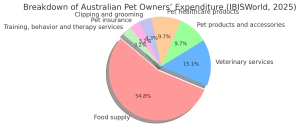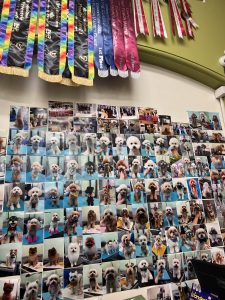
When 33-year-old Sydney resident Peter paid $15,000 for his dog’s stomach surgery, he didn’t think twice. “He’s my family,” he said.
In a country which has the highest pet ownership rates, spending thousands on pet healthcare, insurance, or even dog spas are no longer unusual — but what does this tell us about modern life in Australia?
When Peter adopted his dog Tommy in 2018, he didn’t expect the dog to become his emotional anchor. Now 33 and living in Sydney, Peter wakes up every morning at 6:30 a.m., not because of work — but because Tommy needs his walk.
“He’s my family,” Peter says simply.
That bond was tested recently, when Tommy suddenly fell ill and required emergency stomach surgery. The bill? $15,000. Peter paid it without hesitation.
“It wasn’t even a question,” he says. “I knew I had to do it — I wouldn’t forgive myself otherwise.”
Like many Australians, Peter’s life now revolves around his dog. From $60-a-day doggy daycare when he’s at work to regular grooming sessions and premium food, his spending has quietly stacked up. Yet he considers every dollar well spent.
“I think I probably spend more than the average person,” he admits, laughing. “But he gives me companionship, emotional supporting — honestly, he keeps me sane.”
Peter’s story isn’t rare in Australia. Australians are spending more than ever on their pets — but what does this say about our modern emotional and social lives?
Australian Pet Industry
According to Budget Direct statistics (2024), Australia pet ownership has reached new heights with an estimated 28.7 million pets in 6.9 million households as of 2022. IBISWorld (2024) shows that Australia has one of the highest pet ownership rates globally, with nearly 70% of Australian households owning a pet.
The widespread pet ownership has fostered the flourish of Australian pet economy. “As owners are increasingly treating pets… as valued family members” (Forbes, Trafford, & Surie, 2018), the consumption of pet owners has transferred from basic nursing and caring into various qualitied products and services. Academies describe this trend as the “humanization of pets” – a cultural transformation. Pets are not only considered as life partners but also emotional dependent or even “fur baby”. Such emotional attachment promotes pet owners’ demands for advanced service except for traditional food supply and veterinary nursing.
Australian pet economy has now contained various industries. IBISWorld (2025) shows that pet owners’ expenditure goes to food supply (51%), veterinary services (14%), pet products and accessories (9%) and pet healthcare products (9%), clipping and grooming (4%), pet insurance (3%), and training, behavior and therapy services (3%). These industries cater to owners who are willing to invest in the health, comfort and wellbeing of their pets, reflecting significant shift of consumers’ identity and lifestyle.

Why Spending a Lot?
Australian brooming pet economy isn’t just about consumer’s choices; it’s also a mirror reflecting social reforming. As almost 70% Australian families owning a pet (Budget Direct statistics, 2024), animals are increasingly replacing traditional family members, especially in a society where people’s loneliness increases and households shrinks.
This emotional attachment drives spending beyond necessity, reflecting what scholars call emotional capitalism — where care becomes commodified. As sociologist Eva Illouz (2007) points out, that what Marx (1990/1867) and his followers have defined as the a-emotionality of capitalism refers to negative emotions: anxiety, indifference, and guilt (2007, p. 2). She emphasizes that emotions are not outside the capitalist logic as has been assumed. On the contrary, emotions are deeply ingrained in the language of economics.
However, this trend also exposes the sharp class divides. Grand View Research (2024) notes significant growth in luxury services like pet spas and personalized nutrition, while Gray (2025) reveals that 63% of Australian pet owners struggle with rising pet care costs.

For many people, pets can be both a comfort and a economic burden. The emotional value put on pets might unintentionally intensify owners’ sense of guilty who can’t afford the extra caring fees.

Chloe, a staff member at a busy Sydney pet grooming store, observed that more and more customers tend to choose premium grooming styles such as “Asian-style cuts” with fluffy legs and round faces, reflecting a strong desire to “humanize” pets.
“Usually the most expensive, which is like the fluffy legs. B shades for like fluffy legs, fluffy face is always the cutest one… it’s the cutest style on those dogs is the main thing.” Chloes said.
Sad Fact
Yet beneath the surface of fluffy legs and luxury cuts lies a troubling trend – many designer dogs purchased during the Covid-19 was then abandoned due to the fading of the appearance or behavior. She explained: “because the poodles were older and the color wasn’t as bright anymore. It was like a pale red. And the owners didn’t want them anymore and so there’s a lot of pale red in shelters right now…”
This trend reflects how dogs became accessories during the pandemic – significant emotionally but eventually disposable for some people.
What Choles told us goes with Gray’s statistics. “15% of Australian pet owners reported they couldn’t afford vet care in the past 2 years. Rising costs have led to an increase in pet owners surrendering their pets to animal shelters” (Gray, 2025).
From ethical perspective, the commodification of pets echoes with responsible companion animal ownership principle promoted by animal welfare advocates. “Choosing an appropriate companion animal in consideration of the animal’s physical and mental needs and the owner’s ability to meet these needs, in light of relevant factors such as their family, home, lifestyle, and financial situation.” (RSPCA Australia, 2025)
Questions
This trend raises deeper questions about the future of pet ownership in Australia. Though emotional bond like Peter & Tommy justifies extraordinary spending, the same caring culture also fuels impulsive purchases and eventual abandonment.
In a high pet owner rate country where people’s loneliness increases, pets fulfill emotional needs. But can a system shaped by luxury services and social media aesthetics truly support long-term animal welfare?
What will happen when “fur baby” becomes a life choice? What will happen when owners-pet relationship pattern changes?
As the pet costing keeps increasing, Australian pet owners have to ask themselves a question – Are we nurturing lifelong companions? Or are we consuming affection?
Reference
- Budget Direct. (2024). Pets in Australia survey. https://www.budgetdirect.com.au/pet-insurance/guides/pets-in-australia-survey.html
- Forbes, S., Trafford, S., & Surie, M. (2018, March 22). Pet humanisation: What is it and does it influence purchasing behavior? Journal of Dairy & Veterinary Sciences, 5(2). Juniper Publishers. https://juniperpublishers.com/jdvs/pdf/JDVS.MS.ID.555657.pdf
- Grand View Research. (2025). Australia pet services market size & outlook, 2030. https://www.grandviewresearch.com/horizon/outlook/pet-services-market/australia?utm_
- Gray, E. (2025, April 4). 12 Australia Pet Spending Statistics & Facts: 2025 Update. Hepper. https://articles.hepper.com/pet-spending-statistics-australia/?utm_
- (2024, May). Pets and pet supplies retailers in Australia (Report No. OD5128). IBISWorld. https://www.ibisworld.com/australia/industry/pets-and-pet-supplies-retailers/5128/
- Jeswanth, D. K. (2025, January). Pets and pet supplies retailers in Australia (Report No. OD5128). IBISWorld. https://www.ibisworld.com/australia/industry/pets-and-pet-supplies-retailers/5128/
7. RSPCA Australia. (2025, March 11). RSPCA Policy A2: Responsible companion animal ownership. RSPCA Knowledgebase. https://kb.rspca.org.au/knowledge-base/rspca-policy-a2-responsible-companion-animal-ownership/




Be the first to comment